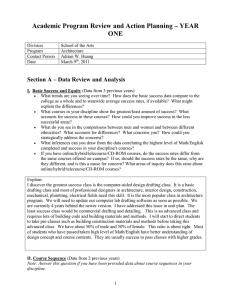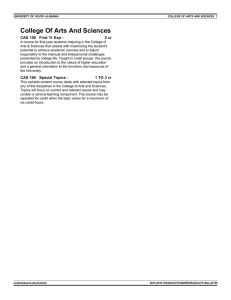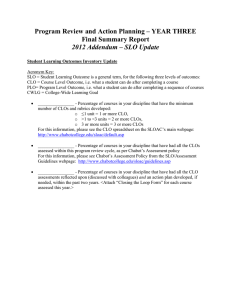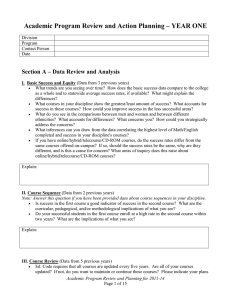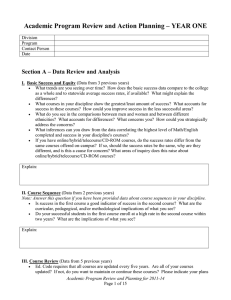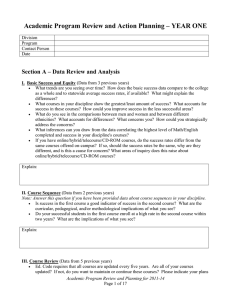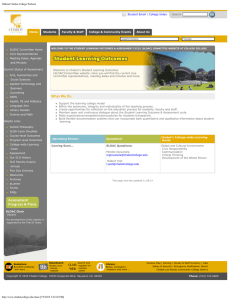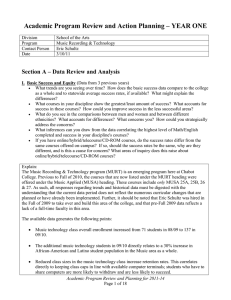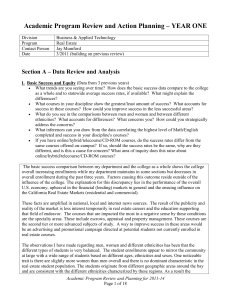Program Review and Action Planning – YEAR TWO
advertisement
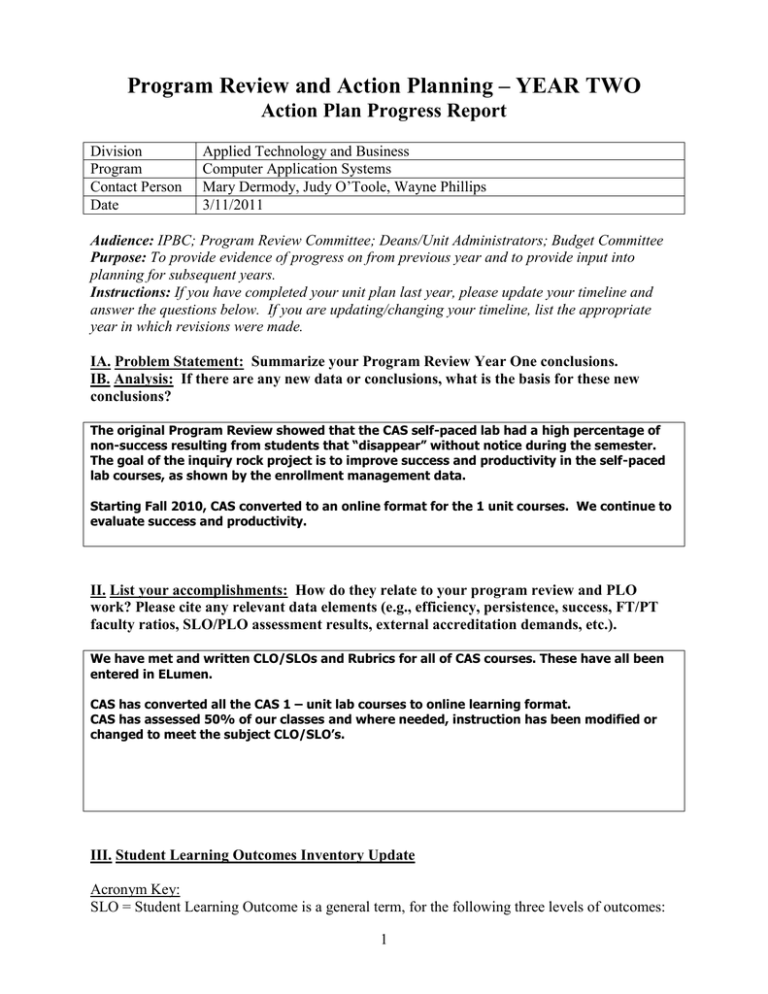
Program Review and Action Planning – YEAR TWO Action Plan Progress Report Division Program Contact Person Date Applied Technology and Business Computer Application Systems Mary Dermody, Judy O’Toole, Wayne Phillips 3/11/2011 Audience: IPBC; Program Review Committee; Deans/Unit Administrators; Budget Committee Purpose: To provide evidence of progress on from previous year and to provide input into planning for subsequent years. Instructions: If you have completed your unit plan last year, please update your timeline and answer the questions below. If you are updating/changing your timeline, list the appropriate year in which revisions were made. IA. Problem Statement: Summarize your Program Review Year One conclusions. IB. Analysis: If there are any new data or conclusions, what is the basis for these new conclusions? The original Program Review showed that the CAS self-paced lab had a high percentage of non-success resulting from students that “disappear” without notice during the semester. The goal of the inquiry rock project is to improve success and productivity in the self-paced lab courses, as shown by the enrollment management data. Starting Fall 2010, CAS converted to an online format for the 1 unit courses. We continue to evaluate success and productivity. II. List your accomplishments: How do they relate to your program review and PLO work? Please cite any relevant data elements (e.g., efficiency, persistence, success, FT/PT faculty ratios, SLO/PLO assessment results, external accreditation demands, etc.). We have met and written CLO/SLOs and Rubrics for all of CAS courses. These have all been entered in ELumen. CAS has converted all the CAS 1 – unit lab courses to online learning format. CAS has assessed 50% of our classes and where needed, instruction has been modified or changed to meet the subject CLO/SLO’s. III. Student Learning Outcomes Inventory Update Acronym Key: SLO = Student Learning Outcome is a general term, for the following three levels of outcomes: 1 CLO = Course-level Outcome, i.e. what a student can do after completing a course PLO= Program-level Outcome, i.e. what a student can do after completing a sequence of courses CWLG = College-wide Learning Goal Percentage of courses in your discipline that have CLOs and rubrics developed:_100%________ For this information, please see the list of which courses do and do not have CLOs on the SLOAC’s main webpage: http://www.chabotcollege.edu/sloac/default.asp Percentage of courses in your discipline that have the minimum number of CLOs developed: (1 unit = 1 or more CLO, 2 units = 2 or more CLOs, 3 or more units = 3 or more CLOs) 100%____ For this information, please see the CLO spreadsheet on the SLOAC’s main webpage: http://www.chabotcollege.edu/sloac/default.asp Date the CLO Assessment schedule was submitted:_2010 For this information, please see the Course-level Outcomes assessment schedules list from the Assessment Progress and Plans webpage: http://www.chabotcollege.edu/sloac/progress.asp Percentage of courses in your discipline that have had all the CLOs assessed within the past three years, as per Chabot’s Assessment policy: 3%_______ For this information, please see Chabot’s Assessment Policy from the SLO/Assessment Guidelines webpage: http://www.chabotcollege.edu/sloac/guidelines.asp Percentage of courses in your discipline that have had all the CLO assessments reflected upon, or discussed with colleagues, within the past three years_0%______ What questions or investigations arose as a result of these reflections or discussions? Explain: On Schedule What actions has your discipline determined that might be taken as a result of these reflections, discussions, and insights? Actions planned: None yet What course-level and programmatic strengths have the assessment reflections revealed? Strengths revealed: None yet 2 Percentage of programs within your discipline that have established at least two PLOs, and mapped appropriate CLOs to them:_0%_______ For this information, please see the Program-level Outcomes progress page from the Assessment Progress and Plans webpage: http://www.chabotcollege.edu/sloac/progress.asp Which of the CWLGs do your discipline’s CLOs address? _ Critical Thinking and Communication In which if any of the College-wide Learning Goals Faculty Inquiry Groups have discipline member(s) participated? None Insights gained: N/A VII. Academic Learning Support What kinds of academic learning support does your discipline use or require to help students succeed (e.g., tutoring, learning assistants, student assistants, peer advisors, lab support, supplemental instruction, peer-led team learning, peer advisors)? How many hours per semester do you use and/or how many hours per semester do you need? Explain: Learning Assistants, tutoring are valuable to our programs. 12 hours weekly. Our programs would benefit from Learning Assistants working 20 hours weekly. This includes traditional and online courses. IV. External Data Cite any relevant external data that affects your program (e.g., labor market data, community demand, employment growth, external accreditation demands, etc.). As identified in the Master Plan, the labor market characteristics and projections indicated the largest job growth area to be office and administrative support occupations. CAS programs are the primary provider of skills training for these occupations. This is also supported by the CAS Advisory Committee. 3 V. Action Plan Timeline Update: Cut and paste your previous timeline from Year One and update the “Accomplished?” column. List any new PLOs or program goals and activities you may have in the second chart. PLOs and/or Program Goal(s) from Year One 1 Timeline 1 year S09-S10 2 Activity Survey non-completing CAS lab students to determine why students left 2 years, S08- Increase breadth of courses: S10. CAS 55, CAS 92 A-D, and new courses for integration with other applications in the Adobe Creative Suite 3 3 years, F08-F11 Support Needed to Accomplish these Activities* None Need more FTEF Integrate SLOAC into all courses No No 4 1 year CAS 55 will be offered in an online format to increase enrollment. 5 1 year CAS 99W – Web 2.0 Tools Outcome(s) Expected Person(s) Responsible Accomplished? Yes/No/In Progress Not necessary. All CAS lab classes offered online. Dermody/O’Toole Cancelled More class offerings for students and will prepare students for employment. Dermody/O’Toole In progress. Not complete due to lack of FTEF SLOACs completed Yes Dermody/O’Toole Yes. Need FTEF 4 Higher enrollment was achieved. Dermody Yes More class offerings for students and will prepare students for employment. O’Toole FTEF’s Reduced New PLOs and/or Program Goal(s) Timeline Activity Support Needed to Accomplish these Activities* Outcome(s) Expected Person(s) Responsible 1 1 year Upgrade to Office 2010 and Widows 7 IT support and training funds. Maintain currency with Industry Standards. Dermody/Seaton/ Clark 2 2 years Office of the Future Courses IT support, Funding and Equipment and FTEF Maintain currency with emerging Industry Standards. Dermody/O’Toole/ Phillips Accomplished? Yes/No/In Progress YEAR TWO LEAVE BLANK 5 Definitions of terms: 1. Program Goal = A general statement of what the program hopes to accomplish, for the long-term. It may be in qualitative (narrative) rather than quantitative (numeric) terms. It may include the integration of several program outcomes, or relate to class scores, credits, units, course completion, retention term to term, progression to next course/level, program completion, degree and certificate completion, transfer, success/scores on licensure exams, job placement, attitudes, fundraising, media promotion, etc. PLO = Program-level Outcome, i.e., what students can do, what knowledge they have, after completing a sequence of courses. It is a subset of the Program Goals, related to student learning. *Types of Support Needed to Accomplish Activities: Training or workshops Publications, library, resources Guidance to support research and/or inquiry projects Technology 12 Program Review and Action Planning – YEAR THREE Final Summary Report Division Program Contact Person Date I. Reflect upon the last three years' analysis and activities. II. Briefly summarize the accomplishments of the discipline, and how they relate to the review of the program, the program-level outcomes (PLOs) and course-level outcomes (CLOs). III. Please list what best practices (e.g., strategies, activities, intervention, elements, etc.) you would recommend? What was challenging? Was there a barrier(s) to success? Best practices: Challenges/Barriers to Success: IV. Next Steps: Recommendations for program and institutional improvement. Program Improvement: Institutional Improvement: 13


